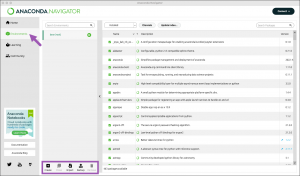Difference between revisions of "Virtual Environments in Python"
| Line 1: | Line 1: | ||
Virtual environments are isolated spaces where you can install specific versions of Python packages without affecting other projects. Using virtual environments ensures that your projects have the dependencies they need without conflicts. A virtual environment is like your specific workshop where you have all the tools and equipments necessary for a spefici project. | Virtual environments are isolated spaces where you can install specific versions of Python packages without affecting other projects. Using virtual environments ensures that your projects have the dependencies they need without conflicts. A virtual environment is like your specific workshop where you have all the tools and equipments necessary for a spefici project. | ||
| − | = | + | =Creating a virtual environment step by step= |
In data analysis and science, projects often rely on different libraries and package versions. Virtual environments help you: | In data analysis and science, projects often rely on different libraries and package versions. Virtual environments help you: | ||
| Line 8: | Line 8: | ||
• Avoid Conflicts: Prevent version clashes between packages. | • Avoid Conflicts: Prevent version clashes between packages. | ||
• Reproducibility: Share your environment setup with others for consistent results. | • Reproducibility: Share your environment setup with others for consistent results. | ||
| − | |||
| − | |||
==Using Anaconda graphic user interface== | ==Using Anaconda graphic user interface== | ||
Revision as of 21:05, 14 September 2024
Virtual environments are isolated spaces where you can install specific versions of Python packages without affecting other projects. Using virtual environments ensures that your projects have the dependencies they need without conflicts. A virtual environment is like your specific workshop where you have all the tools and equipments necessary for a spefici project.
Contents
Creating a virtual environment step by step
In data analysis and science, projects often rely on different libraries and package versions. Virtual environments help you:
• Manage Dependencies: Keep project-specific dependencies separate. • Avoid Conflicts: Prevent version clashes between packages. • Reproducibility: Share your environment setup with others for consistent results.
Using Anaconda graphic user interface
The Environments page, like Conda, allows you to create and activate environments as well as install, update, and remove packages.
Create an environment
Click on the Create button at the bottom of the Environments list. A dialog box appears where you can name your environment and select the versions of Python and/or R you want to work with. You can also choose to import an environment from your local drive or Anaconda Nucleus (Import button) or clone an existing environment (Clone button).
Activate the environment
In the environments list in the left column, click on the arrow button next to the name to activate the environment you want to use.
If you run into problems or want to explore the functions of Anaconda Navigator further, you can access the documentation via the Help button in the top-left corner of the Navigator.
Using conda and the terminal (recommended)
1. Open your terminal or command prompt.
2. Create the environment by specifying a name and the Python version. Remember that is important to consider the Python versions according to your projects and respective libraries you are going to use.
conda create --name myvirtualenvironment python=3.9
Replace `myvirtualenviroment` with your desired environment name, for example, you can put "november_rain" as the name of your environment, and then, instead of `3.9`, the Python version you need.
